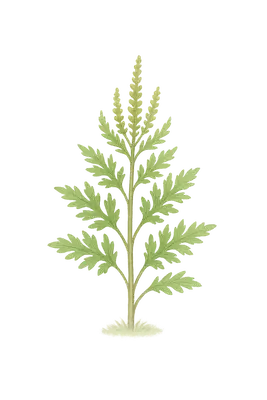Ragweed (Weed)
Description
Ragweed (Ambrosia species) is an annual or perennial herbaceous plant belonging to the Asteraceae family. There are 17 species of ragweed in North America, with common ragweed (Ambrosia artemisiifolia) being the most prevalent. These plants are typically found in fields, roadsides, and disturbed soils, growing between 1 to 6 feet tall. Ragweed is notorious for producing large amounts of pollen, which is a common allergen.

Allergy Symptoms
Exposure to ragweed pollen can cause:
- Nasal symptoms: Sneezing, runny or congested nose.
- Ocular symptoms: Itchy, watery, and red eyes.
- Respiratory issues: Coughing, wheezing, and exacerbation of asthma symptoms.
- Skin reactions: Ragweed pollen can cause rashes that may last anywhere from two to three weeks.
Individuals allergic to ragweed may also experience Oral Allergy Syndrome (OAS), leading to itchy mouth or throat after consuming certain foods such as bananas, melons, and zucchini due to cross-reactivity.
Typical Pollination Period
Ragweed pollinates from late summer to fall:
- United States: August to November, with peak levels in mid-September.
- Europe: Varies by region but generally occurs during similar periods.
Geographic Distribution
Ragweed is predominantly found in:
- North America: Widespread across the United States and Canada.
- Europe: Increasing presence due to accidental introduction and spread.
- Australia: Introduced species found in certain regions.
Tips for Reducing Exposure and Managing Allergies
- Monitor pollen forecasts: Stay informed about local ragweed pollen levels during the pollination season.
- Limit outdoor activities: Especially during mid-morning when pollen levels are typically higher.
- Protect indoor environments: Keep windows closed and use air purifiers to minimize indoor pollen exposure.
- Personal hygiene: Shower and change clothes after being outdoors to remove pollen.
- Dietary considerations: Be cautious with foods that may cross-react with ragweed pollen, such as bananas, melons, and zucchini.
- Medication: Use antihistamines, nasal corticosteroids, or other allergy medications as recommended by a healthcare professional.
- Consult an allergist: For persistent or severe symptoms, seek advice from an allergist who may recommend immunotherapy or other treatments.